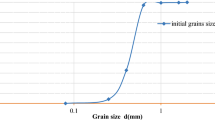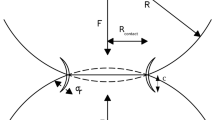Abstract
Determination of crushing strength of granular material is very important for assessing its suitability in various engineering and industrial applications. Laboratory investigations that would yield stress–strain behaviour, and hence, crushing strength of the granular material are extremely cumbersome and time consuming. Also, results obtained from these experiments get influenced by the aspect ratio of the sample, its density, strain rate, size and shape of the grains etc. These difficulties can be overcome by developing a generalized mathematical model, which is primarily based on the physical properties of the granular material such as particle-size and specific gravity, for estimating its crushing strength. With this in view, experiments were conducted on different types of granular materials such as sands, cenospheres (which are found in fly ash and bottom ash) and glass beads, and the results were used for developing such a model. Details of the testing methodology adopted to achieve this are also presented in this paper and validation of the proposed model has been done based on the experimental results and the results reported in the literature.












Similar content being viewed by others
Abbreviations
- δ:
-
deformation of the sample
- ρ:
-
density
- σCR′:
-
crushing strength of sample
- C u :
-
uniformity coefficient
- C c :
-
coefficient of curvature
- d :
-
diameter of the sample
- D x :
-
particle size corresponding to x % finer
- D GB :
-
diameter of glass beads
- D PG :
-
diameter of poorly graded granular material
- e :
-
void ratio
- G :
-
specific gravity
- H :
-
height of the sample
- H/d :
-
aspect ratio
- P :
-
applied load
- MF:
-
multiplication factor
References
Anand L, Gu C (2000) Granular materials: constitutive equations and strain localization. J Mech Phys Solids 48:1701–1733
ASTM D 422-63. (1994) Standard test method for particle size analysis of soils. Annual Book of ASTM Standards, 4.08, ASTM International, West Conshohocken, PA
ASTM D 5550. (2001) Standard test method for specific gravity of soil solids by gas pycnometer. Annual Book of ASTM Standards, 4.08, ASTM International, West Conshohocken, PA
Bartake PP, Singh DN (2005) Determination of crushing strength of cenospheres. J ASTM Int. Published on line, 2(7), 9 pp
Been K, Jefferies MG, Hachey J (1991) The critical state of sands. Geotechnique 41(3):365–381
Bopp PA, Lade PVL (1997) Effects of initial density on soil instability at high pressures. J Geotech Geoenviron Eng ASCE 123(3):671–677
Chuhan FA, Kjeldstad A, Bjorlykke K, Hoeg K (2003) Experimental compression of loose sands: relevance to porosity reduction during burial in sedimentary basins. Can Geotech J 40:995–1011
Coop MR, Lee IK (1993) The behaviours of granular soils at elevated stresses. In Predictive soil mechanics, Thomas Telford, pp 186–199
DeSouza JM (1958) Compressibility of quartz sand at high pressure. M.Sc. Thesis, Massachusetts Institute of Technology, Cambridge, MA, USA
Feda J (2002) Notes on the effects of the grain crushing on the granular soils behaviour. Eng Geol 63:93–98
Ghosal S, Self AS (1995) Particle size density relation and cenosphere content of coal fly ash. Fuel 74(4):522–529
Gupta N, Woldesenbet E, Mensah P (2004) Compression properties of synthetic foams: effect of cenosphere radius ratio and specimen aspect ratio. Compos Part: Appl Sci Manufact 35:103–111
Hagerty MM, Hite DR, Ulrich CR, Hagerty DJ (1993) One-dimensional high-pressure compression of granular media. J Geotech Eng ASCE 119(1):1–18
Hardin BO (1985) Crushing of soil particles. J Geotech Eng ASCE 111(10):1177–1192
http://www.sinosi.com/English/Products%20Gallcry/Our%20New%20Products/Microsphere.htm (sited in June 2005)
JCPDS (1994) Powder Diffraction File, 44, 7354-CD ROM (PDF 1–44), International Centre for Diffraction Data, Pennsylvania, USA
Karner SL, Chester JS, Chester FM, Kronenberg AK, Hajash Jr A (2004) Laboratory deformation of granular quartz sand: implications for the burial of clastic rocks. AAPG Bulletin, 1–57
Kruger RA (1996) The use of cenospheres in refractories. Energeia 7(4):1–5
Mathematica 4. (2000) Wolfram Research Inc., Champaign USA
McDowell GR (2001) Statistics of soil particle strength. Geotechnique 51(10):897–900
McDowell GR, Bolton MD (1998) On the micromechanics of crushable aggregates. Geotechnique 48(5):667–679
McDowell GR, Bolton MD, Robertson D (1996) The fractal crushing of granular materials. J Mech Phys Solids 44(12):2079–2102
Miura N, Murata H, Yasufuku N (1984) Stress–strain characteristics of sand in a particle crushing region. Soils Foundations 24(1):77–89
Morland LW, Sawicki A, Milne PC (1993) Uni-axial compression of granular material. J Mech Phys Solids 41(11):1755–1779
Nakata Y, Hyde AFL, Hyodo M, Murata H (1999) A probabilistic approach to sand particle crushing in the triaxial test. Geotechnique 49(5):567–583
Nakata Y, Hyodo M, Hyde AFL, Kato T, Murata H (2001) Microscopic particle crushing of sand subjected to high pressure one-dimensional compression. Soils Foundations 41(1):69–82
Oztas T, Canbolat M, Sonmez K (1999) Strength of individual soil aggregates against crushing forces II. Influence of selected soil properties. J Agric Forest 23:573–577
Pestana JM, Whittle AJ (1995) Compression model for cohesionless soils. Geotechnique 45(4):611–631
Roberts JE (1964) Sand compression as a factor in oil field subsidence. Ph.D. Thesis, Massachusetts Institute of Technology, Cambridge, MA, USA
Schanz T, Kitamura R (1993) A mechanical model for granular mixtures including particle crushing. Powder Technol 76:33–37
Yamamuro JA, Bopp PA, Lade PV (1996) One-dimensional compression of sands at high pressures. J Geotech Eng ASCE 122(2):147–154
Zheng J, Wong TF, Yanagidani T, Davis DM (1990) Pressure induced microcracking and grain crushing in berea and boise sandstone-acoustic emission and quantitative measurements. Mechanics Mater 9:1–5
Author information
Authors and Affiliations
Corresponding author
Rights and permissions
About this article
Cite this article
Bartake, P.P., Singh, D.N. A generalized methodology for determination of crushing strength of granular materials. Geotech Geol Eng 25, 203–213 (2007). https://doi.org/10.1007/s10706-006-9105-4
Received:
Accepted:
Published:
Issue Date:
DOI: https://doi.org/10.1007/s10706-006-9105-4




